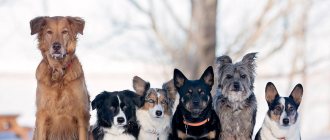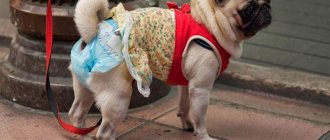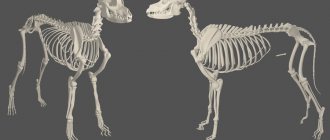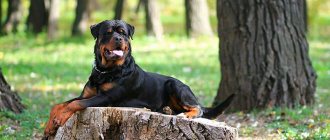There are no clear time limits determining at what age a dog is considered a puppy. It all depends on the breed, as well as a number of related factors: genetics, living conditions, training, nutrition, etc. On average, the main physical growth and psychological development of an animal occurs in the first year of life.
Growing up is a process
It goes without saying, but your puppy is unique! Although puppy development follows a general schedule, don't worry if your puppy doesn't mature at the same rate as his littermates.
Typically, puppies become adult dogs between one and two years .
But that doesn't mean they wake up on the morning of their first birthday and suddenly become adult dogs! In fact, puppy maturation is a process and it varies from dog to dog depending on size, breed, socialization and more.
Features of care
Old dogs require special care and comfortable keeping. By following simple rules, you can improve their quality of life:
- Monitor behavior. Any changes signal the development of any diseases.
- Moderation in physical and mental activity. If your pet gets tired quickly, reduce the walking time.
- Protect your dog from stress. Strong emotional experiences are deadly for old dogs.
- Due to problems with teeth, gums, problems in the digestive tract, appetite worsens or completely disappears. Adjust your diet.
- Set up a comfortable place to relax. Your old man may have to replace his usual lounger with a comfortable house.
What you need to know when your dog gets old
- No drafts, hypothermia, or overheating. Protect from rain, strong wind and cold.
- Pay more attention to grooming, hygiene, care of the coat, claws, and ears.
- If hearing or vision deteriorates, or if the dog is completely deaf, treat the dog more kindly and tenderly.
- Take your dog to the vet 2-3 times a year.
- Older dogs often become thirstier and have problems urinating, so be prepared for the appearance of puddles. Walk your dog more often or use special moisture-wicking diapers.
- Aging dogs, like puppies, are susceptible to infections, so follow the established vaccination schedule.
Sexual and physical maturity of dogs
Most dogs reach sexual maturity at around six months. Puberty is the physical stage at which a dog can physically give birth to puppies. Having puppies can seem very grown-up, but if you've ever spent time with a six-month-old puppy, you know they're not fully grown yet.
Likewise, a puppy may become physically mature before it is fully grown. Physical maturity is when your puppy reaches adult height, which varies by breed. In general, small breeds are fully grown at around 12 months of age, while larger breeds may take one to two years to finish growing.
© shutterstock
In fact, if you've raised a puppy, you've probably experienced the frustration of having a physically mature pet that doesn't quite know how to control its body.
Deviations from the norm and their correction
Knowing how many months dogs grow, you can easily determine deviations from the norm. The most common problems include the following:
- The bitch has problems with lactation or the litter is too large. In these cases, some puppies will be much smaller and weaker than their counterparts. In the wild, such animals die, but thanks to artificial feeding this problem can be avoided.
- Rickets. Develops with hypovitaminosis. The method of treatment depends on the cause of vitamin deficiency, which can only be determined after diagnosis in a veterinary clinic.
- Worms and infections. If babies are not growing well, be sure to get tested for helminths and make sure there are no viruses and bacteria. Remember that until all mandatory vaccinations are completed, your pets’ immunity is very weak and vulnerable.
Record your pet's parameters once a week to prevent lag in height and weight. For this you will need electronic scales and a tape measure.
If you suspect an illness, do not self-medicate. Not all drugs are suitable for a child’s body and can pose a serious threat to life if the wrong dosage is used.
Emotional maturity of dogs
On the other hand, emotional maturity is when a dog acts like a dog and not like a puppy. As with any aspect of a puppy's development, the process of becoming emotionally mature occurs over time. You may not see it, but one day you will realize that your puppy has become a dog.
Emotional maturity coincides with your puppy's hormonal surges leveling out. As puppies grow and become sexually mature, they may act out, test boundaries, and "get into trouble." But somewhere between one and a half years, your puppy will calm down and his adult personality will emerge.
Puppies mature at their own discretion, so it is difficult to determine the exact moment when a puppy becomes an adult. As your puppy grows, watch for signs of emotional maturity:
- Listens and responds appropriately to training
- Calms down easier
- “Listens” and responds to social cues from other dogs.
Sometimes the answer to the question “when is a puppy no longer a puppy” is simple: “when it can be said to be an adult.” This depends on your specific puppy and can happen over time.
Puppy Development Stages
It is customary to distinguish several main stages in the development of dogs.
Sucker
It starts from birth until the mother stops feeding her puppies milk. Until about day 14, babies develop their senses - they learn to walk on all fours, explore their environment, try to play with their littermates, and gain other experiences of “communication” with reality.
After the first two weeks of adaptation to extrauterine life, the socialization of puppies begins. The more they become like dogs, the more clearly their natural instincts manifest themselves. During the games, the teeth begin to be actively involved and an understanding of the strength of the bite is formed, and, consequently, the restrictions “is possible” and “is not possible.” Leadership qualities are demonstrated in the struggle for the most delicious milk nipple, located in the groin area of the lactating bitch.
Puppies
From one and a half months to six months. During this period, there is active growth of tubular bones, teeth, muscles and sternum. With proper care and proper nutrition, the animal grows at the withers and approximately doubles its body weight.
The character also changes. The emotional connection with the mother is finally broken, more independence and self-confidence appear. It is important to start training your dog on time, otherwise it may feel permissive and try to establish its own rules of the game in the house.
Young animals
From 6 to 12 months. Against the background of a noticeable decrease in growth rates and weight gain, hormonal changes in the body begin. In males, testosterone levels increase, and in females their first heat appears. The attitude towards other dogs changes, the so-called flight instinct arises.
On the one hand, the call of nature and the natural search for a partner for mating, on the other hand, the obligation to obey the owner and be obedient. This period is similar to adolescence in humans - approximately 13-15 years. Therefore, the behavior becomes not always adequate: the dog may be nervous, not respond to commands, show anxiety and give other reactions that were not previously characteristic of it.
Ripening
From one to three years. The final formation of the exterior and character. The dog ceases to be a puppy and establishes a clear position of behavior in the pack (among other dogs) and at home. It is almost impossible to challenge leadership or, conversely, try to “restructure” the animal’s temperament.
When to Switch from Puppy Food to Dog Food
Diet is one way to differentiate a puppy from an adult dog. Puppy food contains more calories than adult dog food because growing puppies require more energy to fuel the day. Once your puppy stops growing, you will gradually transition to adult dog food.
In general, you should start switching to adult formula dog food when your puppy stops growing. The exact “when” depends on the size of your dog:
- Small breeds: 9-12 months.
- Medium breeds: about 12 months.
- Large breeds: 12-16 months.
But remember: just because your puppy has stopped growing physically does not mean he is fully mature emotionally and mentally.
© shutterstock
Do external factors affect growth?
Breed is far from the only thing that affects the growth of an animal. In addition to this, the following factors should be taken into account:
- Floor.
Females will always be smaller than males.
- Balanced nutrition.
The better the diet, the stronger your baby will be. The main thing here is not to overdo it and not become obese.
- Health.
Lagging behind peers is possible in the presence of genetic diseases, as well as various infections. During illness, the body spends its energy on maintaining basic functions, postponing the process of growing up until later.
- Activity.
Physical activity allows you to keep your body in good shape. As with feeding, it is important to observe moderation. Otherwise, option 2: extra pounds from inactivity or injury from too much stress.
- Environment.
Constant stress is the same disease. It has a detrimental effect on development and can lead to stunting. It is most difficult for small dogs, as well as some hunting breeds with a delicate psyche.
Try to avoid negative factors and be sure to monitor your pet’s parameters at each of the stages listed above.
How to find out the age of a dog?
If your dog came from a shelter, you may not know exactly when she was born. Wondering how to tell if your new puppy is really a puppy?
Young dogs tend to be more active and energetic. As dogs age, they slow down. But even an older adult dog can have puppy bursts of energy! The best way to tell your dog's age is to observe the physical signs of aging.
Start with their teeth. If your new puppy has shiny white teeth that appear a little small for his jaw, he may be less than 16 weeks old. By the time dogs reach adulthood, they already have permanent teeth.
Other physical signs of aging include:
- Graying around the muzzle
- Cloudy or pale eye color
- Decreased energy or lameness
For dogs that are on the border between puppyhood and adulthood, it can be difficult to guess their exact age. You can always ask your veterinarian to estimate your dog's age.
Behavior of old dogs
As the dog grows, its character develops, the dog learns new skills and acquires new habits. Unbridled energy is replaced by sedateness and slowness.
What you need to know when your dog gets old
The dog becomes jealous, obsessive, demands more attention, withdraws into himself
, goes on “strikes”, refusing to eat, gets offended, showing dissatisfaction with his appearance.
Important!
Older dogs adapt less well to new conditions, be it a change in their usual walking route, a change in their environment or situation.
Treat your aging dog with understanding, be patient with his weaknesses and whims. The animal feels vulnerable, subconsciously counting on your help and support.
Conclusion
Still don't know if your puppy is an adult? Here's a checklist:
- sexually mature
- Physically mature
- Emotionally mature
- Responsive to learning
- Other dogs look at them and react to them as if they were other adult dogs.
Some puppies become dogs at one year of age, and some dogs take up to two years to fully mature. If you don't know how old your dog is, ask your veterinarian.
One way to ensure that your puppy grows into a well-adjusted adult dog is to keep him socialized throughout his puppy years!
Author of the article: Elizabeth Geyer. Elizabeth Geyer is a writer, teacher, and animal advocate with extensive experience with animals and a passion for bully breeds and big orange tabby cats.
Visit to a veterinarian
This is probably not the first time you have visited a veterinarian. The puppy was vaccinated, he underwent anthelmintic procedures, treatment against lice and ticks. Once your pet is older, you'll likely see your veterinarian much less often (once a year is recommended), but by 14 months of age, he'll need booster vaccinations to protect against diseases like rabies, parvoviruses, distemper, and influenza. . This examination is the right time to take measures to protect the dog from parasites: anthelmintic procedures and lice treatment are carried out.
It is also worth talking to your veterinarian during this consultation about the changes that are happening to your pet. Ask questions about exercise, toys, treats, and anything else that needs to be changed now that your puppy is older.
Stages into which dogs grow can be divided
The development of all mammals is divided into two main periods: embryonic and postembryonic. The first stage is the development of the fetus in the womb of the female. In dogs, the duration of the intrauterine period is 58-63 days. In the process, an individual is formed from embryo to fetus (with developed organ systems, body parts, etc.).
Further development occurs after birth and enters the postembryonic period. For dogs, the first year of life is an important stage, as the pet grows and changes over the months. Conventionally, it can be divided into the following intervals:
- Neonatal period (from birth to 18 days of age). At this stage, puppies have developed the instincts of sucking, cuddling, and moving towards warmth. They are unable to defecate on their own. By the end of the period, the eyes and auditory canals open. During the first three weeks of life, puppies grow rapidly - this is an important time when assessing each pet from the litter. Stunted growth and poor weight gain are reasons to consult a veterinarian for advice.
- Up to 3-4 months, as a rule, at this moment the animal finds itself in its permanent habitat. Active growth and formation of the skeleton occurs.
- 5-7 months - the musculoskeletal system continues to grow, teeth change. The puppy develops an attachment to its owner and its character begins to emerge.
- 10-12 months is the approximate age at which a dog grows in height, but only slightly. During this period, puberty occurs in males and females. The animal becomes like an adult.
- From 1 year to 6-7 years, the dog is considered mature, adult. Growth stops completely.
- After 7 years, the period of aging begins: gray hairs appear on the face, the pet becomes less active, excess weight may appear, and chronic processes worsen.
Difficulties at different stages
Having studied the question at what age breeders give puppies, you also need to find out what difficulties can be encountered at each stage of development.
Puppy up to 2 months old
This baby needs extra attention. If it is deficient, it will whine until it ends up in the arms of its owner. In addition, he may get sick more often due to a weakened immune system, and his owner will also have to follow the vaccination schedule.
The baby is still afraid of the world around him. Moreover, fear is inherent not only in small breeds, for example, Chihuahuas, Spitz and others, but also in large dogs.
Dog 2-3 months old
Such an animal will get used to its new owner and this is often difficult. After all, some individuals already begin to manifest their own character and behavior at this time.
It is necessary to create comfortable conditions for the baby
Adult dog
With such a pet it will be much more difficult for the owner, so taking him away is a responsible step. An older dog has a rigid character and behavior, especially if it is a mongrel. In addition, she is used to living by her own rules and orders. It will not be difficult for an experienced dog breeder to cope with it and remake it for themselves, but beginners may not be able to cope at all.
Important! Based on his own strengths and taking into account the difficulties ahead, the owner should decide what time the puppies are taken home from their mother.
Behavior and other signs before starting
The animal’s body itself will tell the owner that the dog is preparing to become a mother. This can be understood by the following signs, you just have to take a closer look at the pet:
- The pug begins to “nest.” The girl is looking for a secluded, quiet place. He tries to arrange it for himself.
- State of apathy.
- Loss of appetite.
- The dog follows its owner and demands his attention.
- Closer to labor, the dog's behavior may change. She will no longer be calm and peaceful. From time to time he will become agitated and scratch his place. There is no need to worry, this is normal. Just continue to monitor the animal and do not leave it alone for a long time.
- Just before birth, about a day before, body temperature drops by one degree. During the process, it will return to normal and rise again to normal levels.
- Contractions can be easily recognized by your pet's rapid breathing. A slight tremor may run through the body.
- During contractions, the amniotic fluid will break and the birth process will begin. Within the first thirty minutes the first baby appears. After a certain period of time the second one and so on.
It is advisable not to miss the moment of childbirth. Pugs can give birth on their own, but if this is their first time, they will need help. They often forget to lick the puppy, remove its bladder and warm it up.
What can and cannot be given
Feeding during walks should only be an encouragement.
During a walk, you can give water in any quantity as your pet requires. Dog treats must be given during training. It is best if it is dry food or crackers for dogs, you can give cubes of carrots or apples.
Giving your dog a treat is just a reward. She should not regard such a treat as a full meal. This means that the number of “goodies” should be minimal.
During a joint outdoor recreation, it is important to protect your pet from hand-treating foods that are unsuitable for dog food. It could be:
- Chocolate and cookies are contraindicated for dogs as they contain sugar.
- Salty snacks with spices disrupt the functioning of the animals' taste buds and sense of smell; the dog simply will not be able to taste such a delicacy.
- Marinated, roasted or canned meats contain salt, vinegar and other seasonings that disrupt digestion.
- Bread and baked goods will lead to obesity.
Attention! A properly raised dog should not ask for food on the street while walking and playing. A dog's food intake should be associated with his bowl and a permanent place for food. If the dog is fed during walks, he will quickly learn to look for and get food outside the home
And most often, from easily accessible food on the street, dogs choose garbage containers and landfills, where they manage to find human waste. The likelihood of contracting diseases and poisoning there is high.
If the dog is fed during walks, it will quickly learn to look for and get food outside the home. And most often, from easily accessible food on the street, dogs choose garbage containers and landfills, where they manage to find human waste. The likelihood of contracting diseases and poisoning there is high.
No matter how much the owner loves his pet friend, it is important to raise him strictly and follow the regime. A dog that is used to eating, walking and playing at the same time will be balanced and calm
Maintaining the balance of the body's systems is also important. Therefore, the dog should walk on an empty stomach and rest after eating.
What you need to be prepared for
Owners of older dogs should be prepared for their pet's departure to another world.
Signs of a dog's imminent death:
- oppression, lethargy;
- lack of appetite, thirst;
- inadequate response to stimuli;
- loss of interest in the outside world;
- weight loss;
- involuntary urination, thirst;
- difficulty breathing, heart rhythm disturbances;
- temperature drop;
- cramps, spasms;
- pallor, change in color of mucous membranes.
What you need to know when your dog gets old
The attitude of owners towards an aging, elderly dog is an indicator of love. Do everything possible to ensure that the last years of your dog’s life are truly happy!
How old is your pet? Tell us in the comments.
Place ? if you liked the article.
Subscribe to the channel.
- Thank you for reading us. —
Early development is very important for future health. Many owners want to know how old their dogs grow. This information will make it possible to control the puppy’s maturation and relieve unnecessary anxiety.
Human to canine age ratio
Many people are interested in how old a pet is in human years. I've been curious about this since childhood! It turns out that there are several techniques that allow you to understand this issue.
The most accurate theory suggests the following calculation: one year of a dog's life is equal to 15 human years, two years - to 24 years. To determine the following ratio, you need to add the number 4 to each last value.
There is also a theory that suggests considering one year of a dog’s life equal to 31 human years and adding 11 years to each subsequent year. Previously, the “year in seven” theory was popular, but now it is actively criticized due to its implausibility. Modern sources talk about the importance of taking into account the average life expectancy of pets of different breeds.
By the way, I have an interesting article on how to determine the age of a cat. I recommend you read it and improve your knowledge!
Temperature
About a day before giving birth, body temperature drops by one degree. The temperature returns to normal with the birth of the last puppy in the litter (38 degrees). After some time it may rise to 39 degrees, but not for long.
If the indicator reaches 40 or higher and lasts for several days, then you need to start sounding the alarm. Perhaps there was a dead puppy in the womb.
If during labor the body temperature does not fall, and the mark on the thermometer only creeps up and the figure reaches 38 degrees or higher, then a doctor is urgently needed. This indicates an inflammatory process.
If the temperature has dropped very low, and childbirth is still far away, then this may be a threat of premature delivery or miscarriage.
What happens on a walk
A dog that runs regularly will get sick less often.
Walking outside is a complex of positive factors for the development and life of a dog.
Fresh air enriches the blood with oxygen. Active games and jogging train the body and muscles. Muscle dynamics stimulate the gastrointestinal tract and nervous system.
Running and jumping help prevent constipation, obesity and joint disease. Dogs undergo socialization during walks, and their psycho-emotional state improves.
Walking and active exercise are good for digestion, but only 3-4 hours after eating. This is the moment when food has already passed from the stomach to the intestines and active absorption of useful elements into the blood occurs.
Attention! It is very useful to accelerate blood circulation at this moment. This way, vitamins and nutrients from food will quickly enter the body’s cells through the blood. Fresh air during this process is prescribed
Fresh air is prescribed during this process.
Decoding and obtaining titles
There are six main titles that can be obtained during exhibitions:
- Champion of Russia (ChR). There are several ways to help you obtain the title of CR. For example, for this you can earn 6 CAC certificates.
- Young Champion (YuChR). This title is a little easier to obtain than the previous one. To do this, you need to obtain four different SACU certificates.
- NKP Champion. The title will be available to dogs that already have a Junior Champion diploma or a CCC certificate.
- Junior ChKP. To quickly receive this title you will need a certificate from the JCC and NKP. Moreover, the certificates received must be from different studios.
- Grand Champion (GChR). The dog will receive the title only if it has a diploma of Russian Champion and National Club Champion.
- Champion of the Federation (BSF). The title will be given to dogs who have four KChF certificates.
Dog shows are interesting events during which dogs are assessed for compliance with standards. People who want to take part in this should familiarize themselves with the features of exhibitions in advance and understand up to what age a dog is considered a junior, puppy and veteran.
The importance of monitoring a dog's development
It is known that dogs grow very actively until they are 6 months old. Subsequent development is no longer so rapid. The rate of weight gain depends not only on their breed qualities, but also on the conditions of detention.
The owner, who cares whether his dog grows up healthy, must constantly monitor how he grows, since this process has its own laws.
There are several factors that ensure the correct and active development of an animal at all stages of its life:
- rational feeding;
- proper physical development;
- developed immune system;
- good hereditary qualities.
During the growth period, first of all, it is necessary to monitor the following parameters:
- timely weight gain;
- increase in size according to the characteristics of the breed;
- changes in appearance according to the exterior;
- acquisition of certain physiological characteristics.











